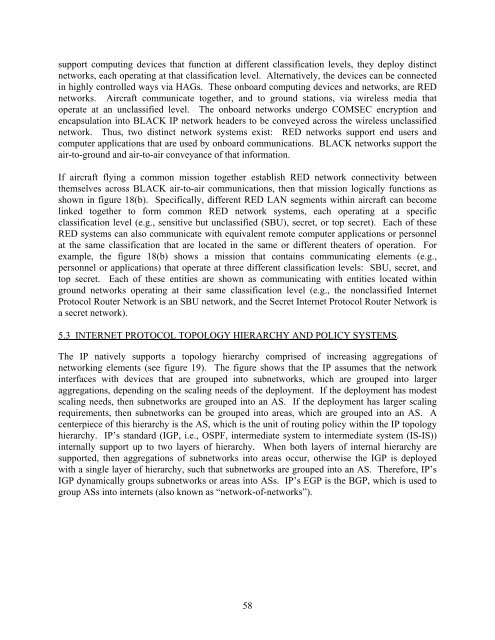Local Area Networks (LANs) in Aircraft - FTP Directory Listing - FAA
Local Area Networks (LANs) in Aircraft - FTP Directory Listing - FAA
Local Area Networks (LANs) in Aircraft - FTP Directory Listing - FAA
You also want an ePaper? Increase the reach of your titles
YUMPU automatically turns print PDFs into web optimized ePapers that Google loves.
support comput<strong>in</strong>g devices that function at different classification levels, they deploy dist<strong>in</strong>ct<br />
networks, each operat<strong>in</strong>g at that classification level. Alternatively, the devices can be connected<br />
<strong>in</strong> highly controlled ways via HAGs. These onboard comput<strong>in</strong>g devices and networks, are RED<br />
networks. <strong>Aircraft</strong> communicate together, and to ground stations, via wireless media that<br />
operate at an unclassified level. The onboard networks undergo COMSEC encryption and<br />
encapsulation <strong>in</strong>to BLACK IP network headers to be conveyed across the wireless unclassified<br />
network. Thus, two dist<strong>in</strong>ct network systems exist: RED networks support end users and<br />
computer applications that are used by onboard communications. BLACK networks support the<br />
air-to-ground and air-to-air conveyance of that <strong>in</strong>formation.<br />
If aircraft fly<strong>in</strong>g a common mission together establish RED network connectivity between<br />
themselves across BLACK air-to-air communications, then that mission logically functions as<br />
shown <strong>in</strong> figure 18(b). Specifically, different RED LAN segments with<strong>in</strong> aircraft can become<br />
l<strong>in</strong>ked together to form common RED network systems, each operat<strong>in</strong>g at a specific<br />
classification level (e.g., sensitive but unclassified (SBU), secret, or top secret). Each of these<br />
RED systems can also communicate with equivalent remote computer applications or personnel<br />
at the same classification that are located <strong>in</strong> the same or different theaters of operation. For<br />
example, the figure 18(b) shows a mission that conta<strong>in</strong>s communicat<strong>in</strong>g elements (e.g.,<br />
personnel or applications) that operate at three different classification levels: SBU, secret, and<br />
top secret. Each of these entities are shown as communicat<strong>in</strong>g with entities located with<strong>in</strong><br />
ground networks operat<strong>in</strong>g at their same classification level (e.g., the nonclassified Internet<br />
Protocol Router Network is an SBU network, and the Secret Internet Protocol Router Network is<br />
a secret network).<br />
5.3 INTERNET PROTOCOL TOPOLOGY HIERARCHY AND POLICY SYSTEMS.<br />
The IP natively supports a topology hierarchy comprised of <strong>in</strong>creas<strong>in</strong>g aggregations of<br />
network<strong>in</strong>g elements (see figure 19). The figure shows that the IP assumes that the network<br />
<strong>in</strong>terfaces with devices that are grouped <strong>in</strong>to subnetworks, which are grouped <strong>in</strong>to larger<br />
aggregations, depend<strong>in</strong>g on the scal<strong>in</strong>g needs of the deployment. If the deployment has modest<br />
scal<strong>in</strong>g needs, then subnetworks are grouped <strong>in</strong>to an AS. If the deployment has larger scal<strong>in</strong>g<br />
requirements, then subnetworks can be grouped <strong>in</strong>to areas, which are grouped <strong>in</strong>to an AS. A<br />
centerpiece of this hierarchy is the AS, which is the unit of rout<strong>in</strong>g policy with<strong>in</strong> the IP topology<br />
hierarchy. IP’s standard (IGP, i.e., OSPF, <strong>in</strong>termediate system to <strong>in</strong>termediate system (IS-IS))<br />
<strong>in</strong>ternally support up to two layers of hierarchy. When both layers of <strong>in</strong>ternal hierarchy are<br />
supported, then aggregations of subnetworks <strong>in</strong>to areas occur, otherwise the IGP is deployed<br />
with a s<strong>in</strong>gle layer of hierarchy, such that subnetworks are grouped <strong>in</strong>to an AS. Therefore, IP’s<br />
IGP dynamically groups subnetworks or areas <strong>in</strong>to ASs. IP’s EGP is the BGP, which is used to<br />
group ASs <strong>in</strong>to <strong>in</strong>ternets (also known as “network-of-networks”).<br />
58
















